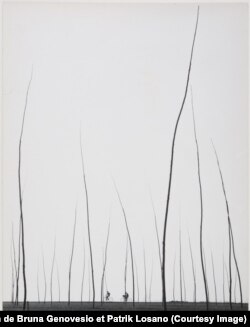“Beauty is in the eye of the beholder” — an old saying that often elicits groans — is just what organizers of an exhibition of 20th and 21st century photographic masterpieces at the Musée de l’Élysée in Lausanne believe and are promoting.
The exhibit, “The Beauty of Lines,” exposes 160 photographs from the extensive, New York-based Sondra Gilman and Celso Gonzalez-Falla collection, considered one of the top five private collections in the world.
“The exhibition is a journey throughout the beauty of photography,” said Tatyana Franck, director of the internationally renowned Swiss photographic museum.
“The show is intended to have visitors experience beauty by how they feel,” she said. “You cannot explain beauty. It is something you feel, depending on your own history.”
Photo Gallery: 'The Beauty of Lines' Exhibit at the Musée de l’Élysée
First time in Europe
This is the first time selected works of the 1,500 original prints from the collection of the husband and wife team are being presented in Europe.
The collection includes the works of 73 master photographers from the United States, Canada, Latin America, Europe and Japan, such as Berenice Abbott, Robert Adams, Henri Cartier-Bresson, Imogen Cunningham, Rineke Dijkstra, Robert Mapplethorpe, Man Ray and Hiroshi Sugimoto.
When she first met the two prominent collectors three years ago, Franck said she was “amazed by their enthusiasm and passion for photography” and their desire “to share their passion with the world.”
Celso Gonzalez-Falla told VOA he saw nothing unusual in that.
“The reason why we buy the photographs and are creating our collection is to share it with the rest of the world,” he said.
Sondra Gilman affirmed that “our philosophy is that no one should or could own art. It belongs to the world. To have wonderful art and have it limited to one family or a small group of people is outrageous.”
Show follows themes
The exhibit itself is not chronological. It is a thematic show that conveys the universality of artistic expression through photographs that explore ideas and concepts of humanity, society and nature without being constrained by time and nationality.
The show is divided into three sections: Lines, Abstractions and Curves.
“Lines, especially straight and parallel lines are used by photographers who want to depict reality,” Franck said. “Straight, vertical and parallel lines are being used by artists not only to document reality, but also to give some sociological messages.”
A noteworthy example of this is a 1933 print, “View of Exchange Place from Broadway,” by American photographer Berenice Abbott. The photo presents an image of a modern town in which tall buildings lean into each other, creating a sense of loneliness and powerlessness among the almost microscopically small people below.
This somewhat claustrophobic image is offset by an expansive view of “The George Washington Bridge,” a photograph by Margaret Bourke-White, the first U.S. female war correspondent and one of the world’s first female photojournalists.
Franck said Bourke-White wanted to glorify the modernity of New York by shooting the bridge within a vertical and short frame. Although the picture was made in 1933, she said, “Today, 100 years later, that print seems and continues to seem modern.”
Unknown artists, too
In a departure from the exhibit’s focus on the works of famous photographers, the photo chosen for the cover of the catalogue is by an unknown Italian artist, Augusto Cantamessa.
The picture, “Breve Orizzonte” (Short Horizon), stands out for its poetic and graceful beauty. It captures a row of pencil thin trees swaying and seemingly straining to leave the frame that confines them. The trees tower over two miniature bikers peddling slowly through this strange forest.
“He was a true discovery for us. We never heard of this photographer,” Franck said. “What makes this collection extremely interesting is Sondra Gilman and Celso Gonzales-Falla … do not have a criterion of names. They have the criteria of quality” when buying a print.
Gilman agreed that she and her husband were not affected by fame.
“We are only affected by the image, by our judgment and emotional reaction,” she said.
Abstractions and Curves
One of the finest examples in the second section, Abstractions, which presents the line in its purest form, is a 1960 picture by U.S. photographer Ray K. Metzker, called “Venice.”
In this photo, as in others in this section, the real world disappears behind abstract lines, creating a different kind of reality. The Metzker picture depicts two black doors split by a large vertical crack through which a sharp, dazzlingly bright light shines. Franck said she was certain that behind the doors she would find “true light and a huge welcoming sun.”
“It is perfection in terms of composition,” she said. “It is like a spiritual experience.”
Curved Lines are represented in the show with works by Edward Weston, Andre Kertesz and Robert Mapplethorpe among others. Curves capture life as it is. They are a symbol of sensuality. Curves show human beings in motion, moving from one situation to another.
The exhibition, which runs through May 6, is beautifully mounted and easily relatable within the intimate setting of the museum. From conversations with visitors, the collection seems to have changed the lens through which some now view photography.
‘Pictures talk to each other’
It even has added a new dimension to the way Gilman and Gonzalez-Falla see their collection.
“It has totally changed the way I look at my own photographs because we never ever analyzed them so distinctly as to isolate line,” Gilman said. “It has opened up a new world to us.”
Gonzalez-Falla had a similar reaction. “We always looked at our photographs because we loved them,” he told VOA. “The show now makes me look at the collection in a different light.”
Calling it a “marvelous installation,” Gonzalez-Falla said that he was particularly impressed with the way the photographs have been hung. “They have the pictures talk to each other.”















